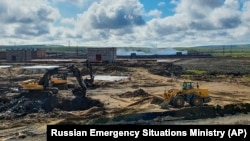A spill that dumped thousands of tons of diesel fuel into the Russian Arctic earlier this year was caused by violations during construction and operation of a storage tank, not permafrost melt, according to a preliminary investigation.
More than 21,000 tons of diesel leaked into the environment from a tank at the power plant near the industrial city of Norilsk in May, causing one of the world’s worst Arctic ecological disasters.
The power plant is owned by a subsidiary of Norilsk Nickel, the world's leading nickel and palladium producer, which had said the leak was caused by pillars supporting a storage tank sinking due to thawing permafrost soil.
Russia's nuclear and environmental watchdog Rostechnadzor said in a statement on November 10 that the disaster was caused by “interrelated technical and organizational violations committed both at the stage of tank construction and during its operation.”
Specifically, it said there were problems with the design and construction of the pile foundation of the reservoir, which did not rest on rocky ground and led to an uneven distribution of the tank.
“At the same time, signs of permafrost degradation under the basement and in the adjacent territory were not found,” it said.
Rostechnadzor, which plans to publish a final investigation on November 13, also said Norilsk Nickel began operating the tank in 2019 after repairs without notifying the authorities and in violation of safety requirements.
The owner of Norilsk Nickel, Vladimir Potanin, is Russia’s richest man. He previously linked the accident to melting of permafrost.
The Prosecutor-General's Office previously issued preliminary findings revealing that sagging ground helped trigger the disaster.
In the wake of the disaster, President Vladimir Putin ordered a state of emergency after the extent of the spill became known.
Norilsk Nickel initially promised to pay for the cleanup, but has disputed the $1.94 billion environmental cost of the spill by Russia's environment watchdog, Rosprirodnadzor.












